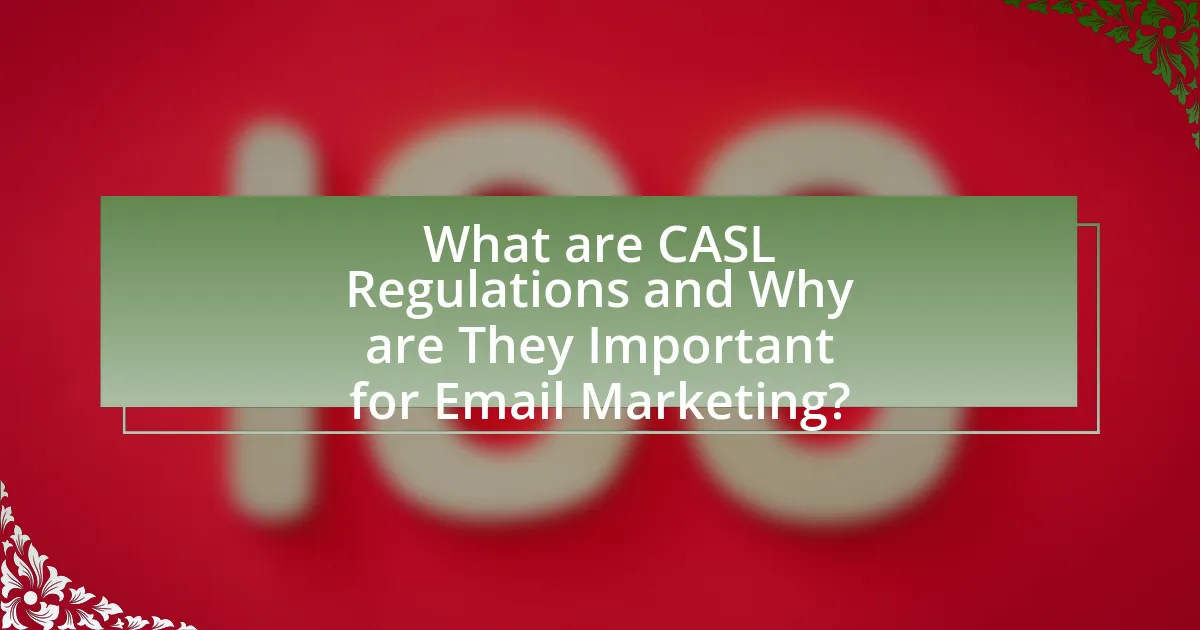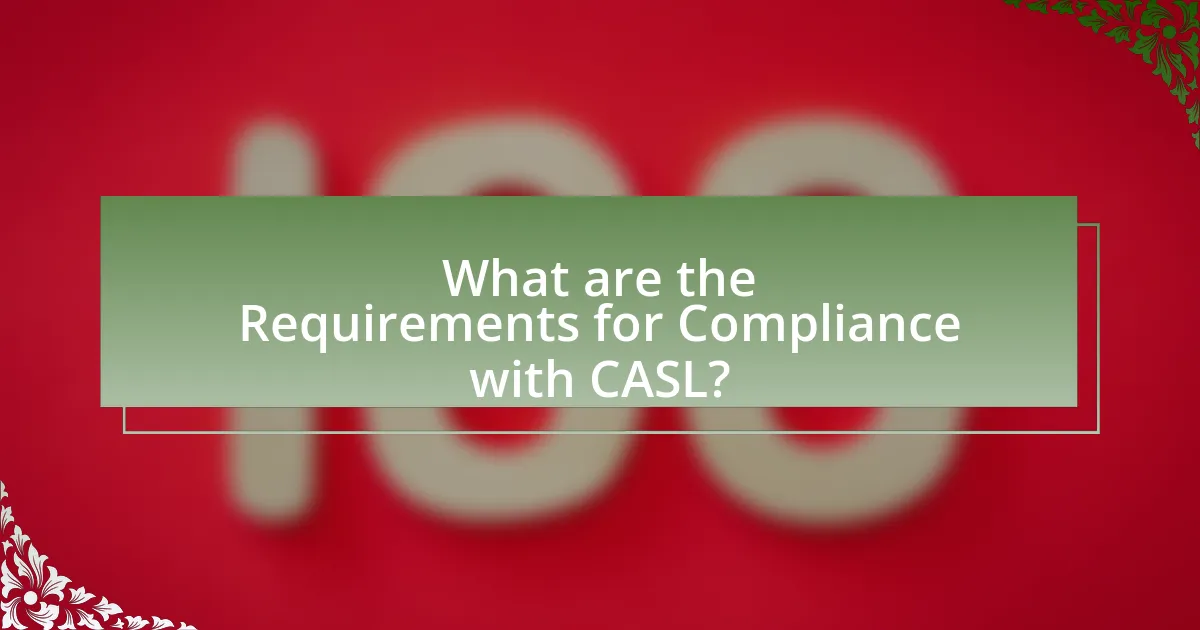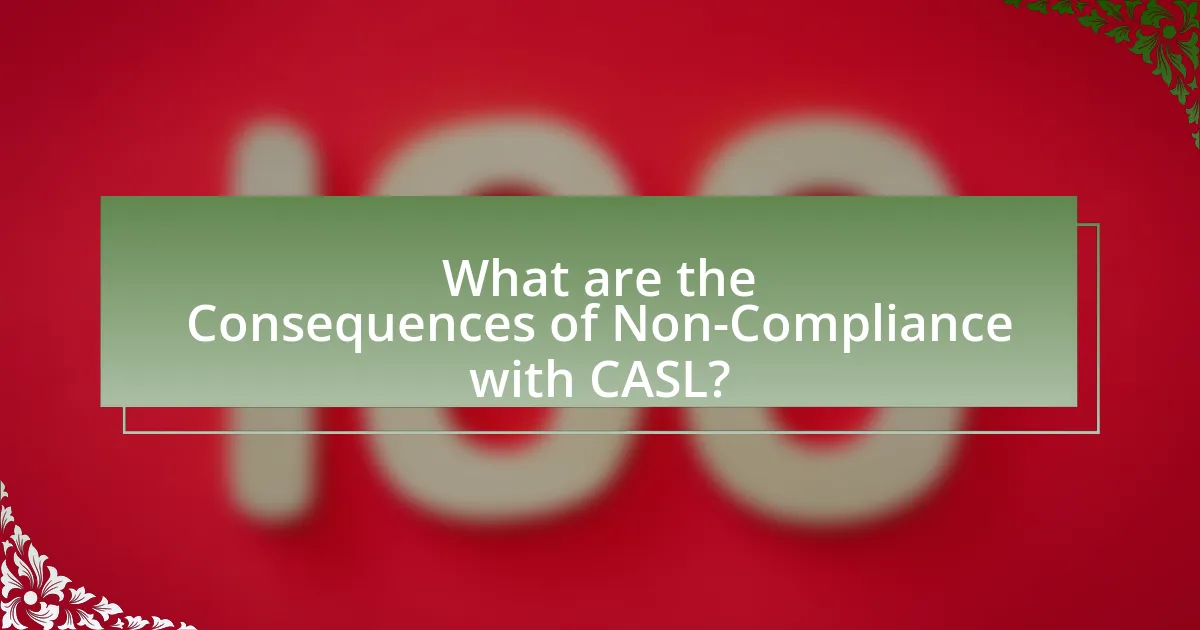The article focuses on the Canadian Anti-Spam Legislation (CASL) and its implications for email marketing in Canada. It outlines the key components of CASL, including the necessity for explicit consent, identification requirements, and unsubscribe mechanisms, which are crucial for compliance. The article also discusses the significant penalties for non-compliance, which can reach up to $10 million, and highlights best practices for businesses to navigate these regulations effectively. Additionally, it compares CASL with global email marketing laws, emphasizing its strict consent requirements and consumer protection objectives.

What are CASL Regulations and Why are They Important for Email Marketing?
CASL regulations, or the Canadian Anti-Spam Legislation, are laws enacted in Canada to regulate commercial electronic messages, including emails, to protect consumers from spam and other electronic threats. These regulations are important for email marketing because they require marketers to obtain explicit consent from recipients before sending promotional emails, thereby ensuring that consumers have control over the communications they receive. Non-compliance with CASL can result in significant penalties, with fines reaching up to $10 million for businesses, emphasizing the necessity for marketers to adhere to these regulations to maintain their reputation and avoid legal repercussions.
How do CASL Regulations impact Canadian businesses?
CASL regulations significantly impact Canadian businesses by imposing strict requirements on how they can communicate electronically with consumers. These regulations mandate that businesses obtain explicit consent before sending commercial electronic messages, which can lead to a reduction in the number of potential customers reached if consent is not properly acquired. Furthermore, non-compliance can result in substantial penalties, with fines reaching up to $10 million for organizations, thereby incentivizing businesses to adopt more transparent and responsible marketing practices. This regulatory framework aims to enhance consumer protection and trust in electronic communications, ultimately influencing how businesses strategize their email marketing efforts.
What are the key components of CASL that marketers need to understand?
The key components of CASL (Canada’s Anti-Spam Legislation) that marketers need to understand include consent, identification, and unsubscribe mechanisms. Consent requires marketers to obtain explicit or implied permission from recipients before sending commercial electronic messages. Identification mandates that marketers clearly identify themselves and provide contact information in their communications. Unsubscribe mechanisms must be included in every message, allowing recipients to easily opt-out of future communications. These components are essential for compliance, as failure to adhere can result in significant penalties, with fines reaching up to $10 million for organizations.
How do CASL regulations differ from other email marketing laws globally?
CASL regulations differ from other email marketing laws globally primarily in their strict consent requirements and penalties for non-compliance. Unlike many jurisdictions that allow for implied consent, CASL mandates explicit consent from recipients before sending commercial electronic messages. Additionally, CASL imposes significant fines, up to $10 million per violation, which is notably higher than penalties in other regions, such as the United States, where the CAN-SPAM Act has a maximum penalty of $43,280 per violation. This stringent approach reflects Canada’s emphasis on consumer protection and privacy, setting CASL apart from more lenient frameworks found in countries like the UK or Australia, where opt-out mechanisms are more commonly accepted.
What are the main objectives of CASL?
The main objectives of CASL (Canada’s Anti-Spam Legislation) are to protect Canadians from unsolicited commercial electronic messages, enhance the privacy of individuals, and promote the efficiency of electronic commerce. CASL aims to establish a framework that requires businesses to obtain consent before sending commercial emails, thereby reducing spam and ensuring that recipients have control over their personal information. The legislation also includes provisions for the installation of computer programs and the alteration of transmission data, further safeguarding users against malicious activities.
How does CASL aim to protect consumers?
CASL, or the Canadian Anti-Spam Legislation, aims to protect consumers by establishing strict rules for sending commercial electronic messages. These rules require businesses to obtain explicit consent from recipients before sending emails, ensuring that consumers have control over the communications they receive. Additionally, CASL mandates that senders provide clear identification and an easy opt-out mechanism in every message, which further safeguards consumer interests by allowing them to unsubscribe easily. The legislation also imposes significant penalties for non-compliance, reinforcing the importance of consumer protection in digital communications.
What role does consent play in CASL regulations?
Consent is a fundamental requirement in the Canadian Anti-Spam Legislation (CASL) regulations, as it establishes the legal basis for sending commercial electronic messages (CEMs). Under CASL, organizations must obtain express or implied consent from recipients before sending CEMs, ensuring that individuals have control over their personal information and communication preferences. Express consent requires a clear and affirmative action from the recipient, while implied consent can arise from existing business relationships or interactions. The importance of consent is underscored by the fact that non-compliance can result in significant penalties, including fines up to $10 million for organizations. This regulatory framework aims to protect consumers from unwanted communications and enhance trust in electronic marketing practices.

What are the Requirements for Compliance with CASL?
To comply with the Canadian Anti-Spam Legislation (CASL), organizations must obtain express consent from recipients before sending commercial electronic messages (CEMs). This consent must be clear, unambiguous, and provided voluntarily, ensuring that recipients understand what they are consenting to. Additionally, organizations must provide accurate sender information and a clear unsubscribe mechanism in every CEM, allowing recipients to easily opt-out of future communications. Failure to adhere to these requirements can result in significant penalties, as CASL is enforced by the Canadian Radio-television and Telecommunications Commission (CRTC), which has the authority to impose fines for non-compliance.
What constitutes valid consent under CASL?
Valid consent under the Canadian Anti-Spam Legislation (CASL) requires that individuals provide explicit permission to receive commercial electronic messages. This consent must be informed, meaning the recipient understands what they are consenting to, including the identity of the sender and the purpose of the communication. CASL mandates that consent can be obtained through various means, such as written or oral agreements, but it must be clear and unambiguous. Additionally, the sender must keep records of consent to demonstrate compliance with the law.
How can businesses obtain express consent from recipients?
Businesses can obtain express consent from recipients by providing clear and specific information about the purpose of the communication and obtaining an affirmative action from the recipient, such as clicking a checkbox or signing a form. Under the Canadian Anti-Spam Legislation (CASL), express consent must be obtained before sending commercial electronic messages, and the consent must be documented. This requirement ensures that recipients are fully informed and agree to receive communications, thereby protecting their rights and preferences.
What are the implications of implied consent?
Implied consent under the Canadian Anti-Spam Legislation (CASL) allows organizations to send commercial electronic messages to individuals based on certain conditions, primarily when there is an existing business relationship or when the recipient has provided their email address in a public context. This form of consent has significant implications for email marketing strategies, as it enables marketers to reach potential customers without obtaining explicit consent, provided they adhere to the regulations set forth by CASL.
For instance, businesses can rely on implied consent for up to two years after a purchase or transaction, which facilitates ongoing communication with customers. However, organizations must ensure that they clearly identify themselves and provide an easy opt-out mechanism in their communications to comply with CASL requirements. Failure to adhere to these regulations can result in substantial penalties, reinforcing the importance of understanding the nuances of implied consent in email marketing practices.
What information must be included in commercial electronic messages?
Commercial electronic messages must include the sender’s identification, a clear and specific subject line, and an unsubscribe mechanism. The sender’s identification requires the name and contact information of the individual or organization sending the message. A clear subject line must accurately reflect the content of the message. Additionally, an unsubscribe mechanism must be provided, allowing recipients to easily opt-out of future communications. These requirements are mandated by the Canadian Anti-Spam Legislation (CASL) to ensure transparency and consumer protection in email marketing practices.
What are the identification requirements for senders?
Senders must provide clear identification in their emails, including their name and either a physical mailing address or a telephone number. This requirement is mandated by the Canadian Anti-Spam Legislation (CASL), which aims to ensure transparency and accountability in electronic communications. The identification must be easily accessible and visible to recipients, allowing them to recognize the sender and contact them if necessary. Compliance with these identification requirements is crucial for legal adherence and maintaining trust with recipients.
How should unsubscribe mechanisms be implemented?
Unsubscribe mechanisms should be implemented by providing a clear and accessible option for recipients to opt-out of future communications. This mechanism must be easy to find, typically included in every email, and should allow users to unsubscribe with a single click. According to the Canadian Anti-Spam Legislation (CASL), organizations are required to honor unsubscribe requests within 10 business days, ensuring compliance with legal standards. Additionally, the unsubscribe process should not require recipients to log in or provide personal information, as this can deter users from completing the action.

What are the Consequences of Non-Compliance with CASL?
Non-compliance with the Canadian Anti-Spam Legislation (CASL) can result in significant financial penalties and legal repercussions. Organizations found in violation of CASL may face fines up to $10 million for businesses and $1 million for individuals per violation. Additionally, non-compliance can lead to reputational damage, loss of customer trust, and potential lawsuits from affected individuals or organizations. The enforcement of CASL is managed by the Canadian Radio-television and Telecommunications Commission (CRTC), which actively investigates complaints and can impose sanctions on non-compliant entities.
What penalties can businesses face for violating CASL?
Businesses can face significant penalties for violating the Canadian Anti-Spam Legislation (CASL), including fines up to $10 million for corporations and $1 million for individuals per violation. The enforcement of these penalties is managed by the Canadian Radio-television and Telecommunications Commission (CRTC), which has the authority to impose these fines based on the severity and frequency of the violations. In addition to monetary penalties, businesses may also face private lawsuits from individuals or organizations affected by the spam, further increasing their financial liability.
How can businesses mitigate the risk of penalties?
Businesses can mitigate the risk of penalties under CASL regulations by ensuring compliance with all requirements related to consent, identification, and unsubscribe mechanisms. Implementing a robust email marketing strategy that includes obtaining explicit consent from recipients before sending commercial electronic messages is essential. According to the Canadian Radio-television and Telecommunications Commission (CRTC), failure to secure proper consent can lead to significant fines, with penalties reaching up to $10 million for organizations. Regularly reviewing and updating email lists to remove non-compliant contacts, providing clear identification of the sender, and including a straightforward unsubscribe option in every email further reduce the risk of incurring penalties.
What are some common mistakes that lead to non-compliance?
Common mistakes that lead to non-compliance with CASL regulations include failing to obtain proper consent, not providing clear identification of the sender, and neglecting to include an unsubscribe mechanism in emails. For instance, organizations often overlook the requirement to obtain express consent from recipients before sending commercial electronic messages, which is a fundamental aspect of CASL. Additionally, many marketers do not clearly identify themselves or their business in communications, which can mislead recipients and violate transparency requirements. Lastly, the absence of a straightforward unsubscribe option can result in non-compliance, as CASL mandates that recipients must be able to easily opt out of future communications. These mistakes can lead to significant penalties, reinforcing the importance of adhering to the regulations.
How can businesses effectively navigate CASL regulations?
Businesses can effectively navigate CASL regulations by ensuring they obtain explicit consent from recipients before sending commercial electronic messages. This involves implementing a clear opt-in process, where individuals actively agree to receive communications, and maintaining comprehensive records of consent. According to the Canadian Radio-television and Telecommunications Commission (CRTC), compliance with CASL requires businesses to provide clear identification, include an unsubscribe mechanism in every message, and honor unsubscribe requests promptly. Failure to adhere to these regulations can result in significant penalties, with fines reaching up to $10 million for organizations.
What best practices should be followed for compliant email marketing?
To ensure compliant email marketing under CASL regulations, businesses must obtain explicit consent from recipients before sending commercial electronic messages. This consent must be clear, unambiguous, and documented, as outlined in the Canadian Anti-Spam Legislation (CASL). Additionally, marketers should provide accurate sender identification and include an easy-to-use unsubscribe mechanism in every email, allowing recipients to withdraw consent at any time. According to the Canadian Radio-television and Telecommunications Commission (CRTC), failure to adhere to these practices can result in significant penalties, reinforcing the importance of compliance in email marketing strategies.
How can businesses stay updated on changes to CASL regulations?
Businesses can stay updated on changes to CASL regulations by regularly consulting the official website of the Canadian Radio-television and Telecommunications Commission (CRTC), which oversees CASL compliance. The CRTC provides timely updates, guidelines, and resources related to the regulations. Additionally, subscribing to industry newsletters, attending webinars, and participating in relevant professional associations can further enhance awareness of any amendments or interpretations of CASL. These methods ensure that businesses remain informed about compliance requirements and best practices in Canadian email marketing.
What practical tips can help ensure compliance with CASL?
To ensure compliance with the Canadian Anti-Spam Legislation (CASL), businesses should obtain explicit consent from recipients before sending commercial electronic messages. This means clearly informing individuals about the purpose of the communication and providing an easy way for them to opt-in. Additionally, organizations must maintain accurate records of consent, including the date and method of acquisition.
Furthermore, businesses should include their contact information and a clear unsubscribe mechanism in every message, allowing recipients to easily withdraw consent at any time. Regularly reviewing and updating email lists to remove inactive subscribers also supports compliance. According to the Canadian Radio-television and Telecommunications Commission (CRTC), failure to adhere to these practices can result in significant penalties, reinforcing the importance of following these guidelines.




